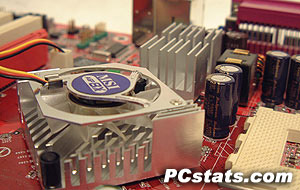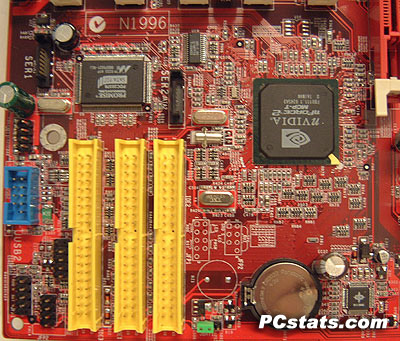
|
Well equipped with SATA/IDE RAID, 10/100 LAN, IEEE 1394, USB 2.0, 6-channel audio, TV-out and of course nVIDIA's integrated video.
84% Rating: 
|
|
|
|
Home >
Reviews >
Motherboards >
MSI K7N2G-ILSR |
|
|
Close up with the K7N2G-ILSR
 In typical MSI fashion, the
K7N2G-ILSR uses a bright red PCB which should appeal to the case modders out
there. The K7N2G-ILSR is a standard sized ATX board (30cm x 23cm), though a
little slimmer than a P4 equivalent so there shouldn't be any problems
installing this motherboard into smaller cases. In typical MSI fashion, the
K7N2G-ILSR uses a bright red PCB which should appeal to the case modders out
there. The K7N2G-ILSR is a standard sized ATX board (30cm x 23cm), though a
little slimmer than a P4 equivalent so there shouldn't be any problems
installing this motherboard into smaller cases.
Since
MOSFETs generate quite a bit of heat it's nice to see that passive
heatsinks have been applied to aide cooling. Little things like this show
how dedicated a company is to quality. There are only two fan headers on this
board, and one of those is used
by the northbridge fan which is kind of frustrating.
Headers
and connectors though are all well labeled so you loose the manual in time all
is not lost. Unlike most of the nForce2 SPP based motherboards we have
tested, an active heatsink has been installed. MSI's cooling solution is a
custom heatsink which also blows air in the direction of the MOSFET's
- a good sign since the nForce2-IGP
Northbridge can get quite toasty after a few hours workout.
In
addition to the standard 20-pin ATX power connecter used to power all ATX
motherboards on the planet, this AMD motherboard also has the
aptly named 12V auxiliary "P4"
power connector. The two power connectors are positioned just left
of the CPU socket so the cables will have to run in front of the CPU fan
which could disrupt airflow to the processor if they are left to hang to close.
It would be a good idea to use a fan with a grill for this particular motherboard
to ensure that those power cables never have a chance of getting caught
up in the fan impeller blades incidently.

The lower right hand corner of the motherboard is quite
busy, but that's expected with board of this size. In that corner are three IDE
headers, two Serial ATA headers and an assortment of USB, bluetooth, and front
panel connectors. Full length PCI cards should be useable without interference with all these cables in slot one
and two. Up next, heatsink clearance measurements, and some words on a little thing I like to call
overclocking...
|
